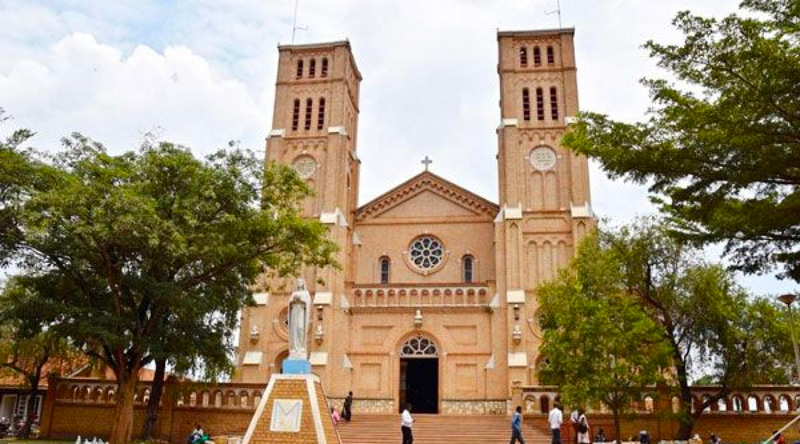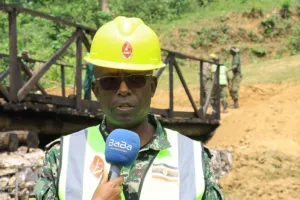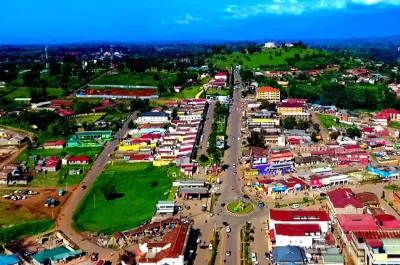
The Archbishop of Kampala, Most Rev. Paul Ssemogerere, has officially clarified the true name of the cathedral on Lubaga Hill to clear up years of confusion among the faithful and within Church records.
For generations, the cathedral, located on the former site of Kabaka Muteesa’s palace, has been referred to by several names: Sacred Heart Cathedral, St. Mary’s Cathedral, or St. Mary’s Sacred Heart Cathedral. Addressing thousands gathered for its centenary celebrations, Archbishop Ssemogerere announced that, after verifying archival records in Rome, the official name is St. Mary’s Cathedral, Lubaga.
Symbolism and Celebration
The celebration began with the Archbishop lighting candles on both the altar and the church’s twenty-four pillars. The Master of Ceremonies explained that the pillars hold symbolic meaning, twelve represent the 12 tribes of Israel, and the other twelve represent the 12 apostles of Christ, all converging toward the altar where Christ offers Himself in the Mass.
During his homily, Archbishop Ssemogerere urged the faithful to use the centenary as a time for reflection on the faith, sacrifice, and vision of the Church’s early missionaries, especially the White Fathers, who laid the foundation of Catholicism in Uganda. He described the last hundred years as “a journey of gratitude for their faith, service, and dedication to spreading the Gospel.”
A Cathedral of Faith and History
Archbishop Ssemogerere emphasized that Lubaga Cathedral is not only a sacred symbol of faith but also a cornerstone of Uganda’s Catholic heritage. He reminded the congregation that the cathedral holds a special place in African Catholicism as the first cathedral on the continent to host a Pope.
He recalled that Pope Paul VI’s historic visit in 1969 remains a defining moment in the Church’s memory. During the Mass, the Archbishop held aloft the same crosier that Pope Paul VI used and later gifted to the Archdiocese, a tangible reminder of that momentous occasion in Uganda’s faith journey.
Lubaga Cathedral has since welcomed two more Popes, John Paul II in 1993 and Francis in 2015, making it one of the few cathedrals in Africa to have received three pontiffs.
Ordinations and Interfaith Significance
Over the years, the cathedral has hosted three episcopal ordinations, including those of Archbishop Augustine Kasujja (the first African Papal Nuncio), Bishop Joseph Mukwaya, and Bishop Christopher Kakooza. It has also been the site of countless priestly ordinations for clergy of both the Kampala Archdiocese and missionary congregations.
The Archbishop highlighted that the cathedral’s influence extends beyond the Catholic community, serving as “a beacon of Christian unity.” It has welcomed leaders from the Anglican, Orthodox, and other Christian denominations, promoting interfaith dialogue and cooperation throughout Uganda.
Call to Spiritual Renewal
After recounting the cathedral’s milestones, Archbishop Ssemogerere urged believers not to regard it merely as an architectural monument. He reminded them that “their bodies are also temples of God” and must be treated with the same reverence. The Archbishop encouraged the faithful to let the celebration inspire personal renewal, calling on each person to live in a way that reflects the holiness symbolized by the cathedral.
About St. Mary’s Cathedral, Lubaga
St. Mary’s Cathedral can accommodate over 5,000 worshippers, making it one of Uganda’s most striking architectural landmarks. The church measures 248 feet long and 63 feet wide, excluding the walls, with a transept extending 152 feet and a ceiling height of 50 feet. Construction required about 2.5 million bricks, underscoring the magnitude of the project.
Inside are three altars, the main altar, the altar of St. Theresa of the Child Jesus, and the Martyrs’ Altar. The latter was hand-carved by Brother Bonaventure from wood taken from the martyrdom site of St. Matia Mulumba, giving it profound spiritual meaning.
Construction of St. Mary’s Cathedral, Lubaga, began in 1914 and concluded in 1925. The twin-towered Romanesque structure stands on what was once the palace of Kabaka Muteesa I, father of Mwanga.
Historical Background
According to St. Mary’s Cathedral Lubaga by Fr. Yves Tourigny (WF), the current cathedral is the seventh church to stand on Lubaga Hill. Between 1891 and 1914, six earlier cathedrals built from various materials were successively destroyed.
The first church (1891) was burned down on January 24, 1892, during religious conflicts. Within a year, two grass-thatched churches were erected; one was demolished by an earthquake, and the other burned down by Protestants (Anglicans).
Undeterred, the Christians of Lubaga built another temporary church in 1893, replaced by a sturdier one in 1894. This served until 1901, when a larger structure became necessary to accommodate the growing Catholic population.
The sixth church, constructed in 1901, was made of sun-dried bricks with a grass-thatched roof, measuring 71 feet long and 21 feet wide. Blessed by Bishop Henry Hanlon on March 19, 1901, it served the faithful for 24 years before the construction of the current magnificent cathedral began.














Sunrise reporter
Leave a Comment
Your email address will not be published.